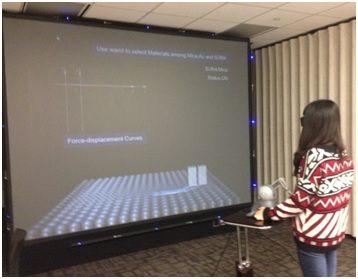Faculty:
Dr. Xiaobo Peng
Tel: (936) 261-9959
Email: xipeng@pvamu.edu
Research Interest:
CAD/CAM/CAE, Product Design, Virtual Reality, Collaborative Engineering Design, Engineering Education
Research Activities:
1. Advancing the Complex Product Design Using Virtual Reality Techniques (Funded by National Science Foundation)
The research goal is to advance the ability of complex product design especially freeform shape modeling with Virtual Reality techniques. In pursuit of this goal, the research objective is to investigate a virtual sculpting modeling and simulation technique for freeform geometry design. Freeform models have wide applications in the aerospace, automobile, mold/die making, biomedical products etc. The research approach is to apply virtual sculpting method by interactively carving a work piece using a virtual tool. Boolean operations between the model and the tool are executed to change the geometry and materials of the design model simultaneously. Haptic interface is incorporated to reflect the interaction between the tool and the model during sculpting process. The virtual sculpting process is then integrated into the large scale PowerWall virtual environment.
Fig.1 AFM simulation using PowerWall Virtual Reality System
2. Building a Learner-centered Cyberlearning Environment in Computer-Aided Design Education (Funded by National Science Foundation)
The major goals of this project are to enhance the students’ learning of computer-aided design (CAD) and promote their life-long learning skills and cultivate positive engineering attitudes by building a learner-centered cyberlearning environment.
3. Widening Implementation of Evidence-Based Pedagogies in STEM Education (Funded by US Department of Education)
The overarching goal of this project is to increase the number of minority students, particularly minority women, in STEM fields by transforming the culture of STEM education in Prairie View A&M University (PVAMU). The project has the following specific objectives: (1) Transforming the perception of STEM faculty on the adoption of evidence-based pedagogies; (2) Activating participating STEM faculty’s self-reflection and meta-cognition in evidence-base pedagogies by fully engaging them in educational design and research; (3) Improving students’ learning in the first two year of college; (4) Increasing the number of minority students, particularly minority women, in STEM fields.
Selected Publications:
1. Liu, K. and Peng, X., 2016, “Simulating the Approach-retract Phenomenon of AFM in Virtual Environment with Haptic Interface,” Computer–Aided Design and Applications.
2. Liu, K., Peng, X., McGary, P., Yalvac, B., Ozturk, E., Johnson, M., and Valverde, L., 2015, “Integration of Contextual Exercises in Computer-aided Design Education,” Computer–Aided Design and Applications, 12(Supplement 1), pp. 13-21. http://dx.doi.org/10.1080/16864360.2015.1077071.
3. Peng, X. and Isaac, B., 2015, “Haptic Interface Technique in Large-Scale Virtual Environment,” Computer–Aided Design and Applications, 12(5), pp. 601-607. http://dx.doi.org/10.1080/16864360.2015.1014739
4. Peng, X., McGary, P., Ozturk, E., Yalvac, B., Johnson, M., and Valverde, M., 2014, “Analyzing Adaptive Expertise and Contextual Exercise in Computer-Aided Design,” Computer–Aided Design and Applications, 11(5), pp. 597-607.
5. Peng, X., Isaac, B., and Wilkins, R., 2013, “Development of Nanoscale Virtual Reality Simulations for the Teaching of Nanotechnology,” Computers in Educational Journal, 4(1), pp. 25-34.
6. Peng, X., McGary, P., Johnson, M., Yalvac, B., and Ozturk, E., 2012, “Assessing Novice CAD Model Creation and Alteration Procedures,” Computer–Aided Design and Applications, PACE(2), pp. 9-19.
Research Facilities:
1. Virtual Reality Facilities:
PowerWall Virtual Reality System
Two PHANToM Omini Haptic Devices
WorldViz
OpenHaptics Toolkit
Freeform Modeling system
2. Collaborative Engineering Design Facilities:
Two High-end Sun servers (x2100)
Thirty Five High-end HP engineering workstations
Tandberg Video conference system
NX (CAD)
Teamcenter Community 5.2 (Collaboration)
MAC. ADAMS, Altair. HyperWorks, and ANSYS (CAE)
Video and audio conferencing software

